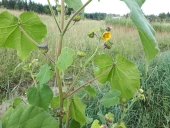

Alder Burns wrote:On clay soil, whatever else you do, DON'T dig a big hole and put in all kinds of soil amendments, compost, organic matter, etc. and then plant the tree in that. When it rains heavy the water will collect in the increased pore space in that spot and not soak easily into the surrounding clay, and if this happens during the growing season the tree will quickly drown! I have learned this the hard way on more than one site! Plant the tree into the unimproved clay rather, and add any soil amendments on top as a mulch, or perhaps (especially if they are "nasty" amendments like humanure or roadkill or some such) buried in holes BESIDE and not UNDER the roots. In many heavy clay soils it is often a good idea to plant the trees on shallow mounds, or even little raised beds, and the soil in these mounds can be thoroughly improved since the excess water can drain down and out. The only exceptions might be if the trees are on a pretty good slope, or perhaps the mound portion of a swale, or some other such freely-draining location. This is mostly a problem for young trees, so if your mounds gradually settle and level out as the trees mature it won't be a problem. Some varieties are worse sensitive than others and often grafting rootsocks are chosen for "sogginess" tolerance.


Miles Flansburg wrote:In Colorado and Wyoming I have harvested lots of crawfish from everyplace from ditches to giant reservoirs. I am wondering about the need for lots of oxygenation. Many of these waters were slow moving and murky. The crawfish lived in holes in the muddy banks or under rocky outcrops. When I was young I found one frozen in ice, solid, I thawed it out and it crawled away ! So it seems to me that they are pretty hardy and wouldn't need much special care.




